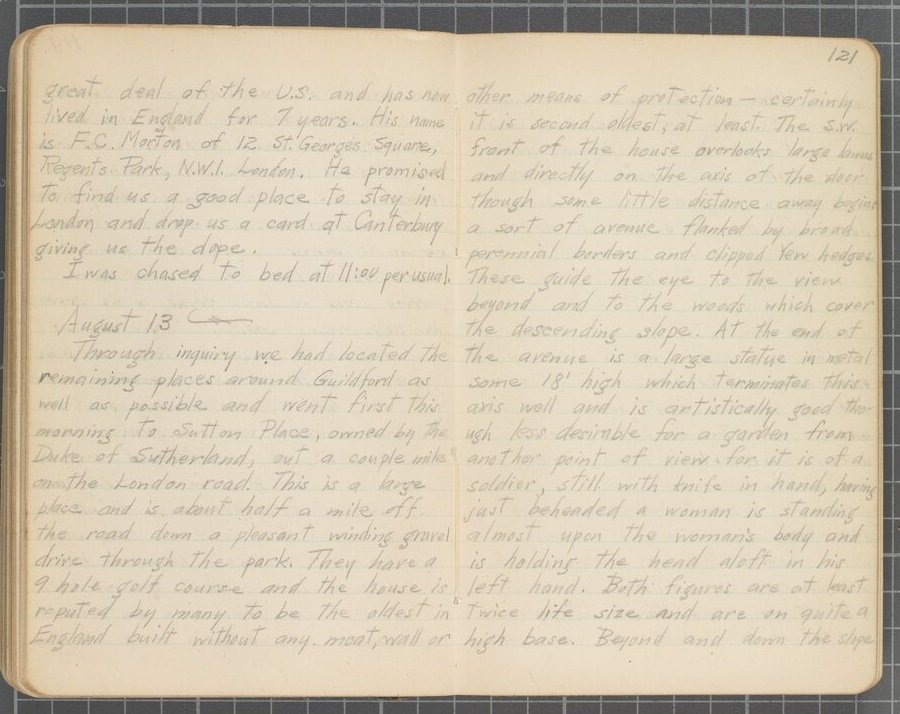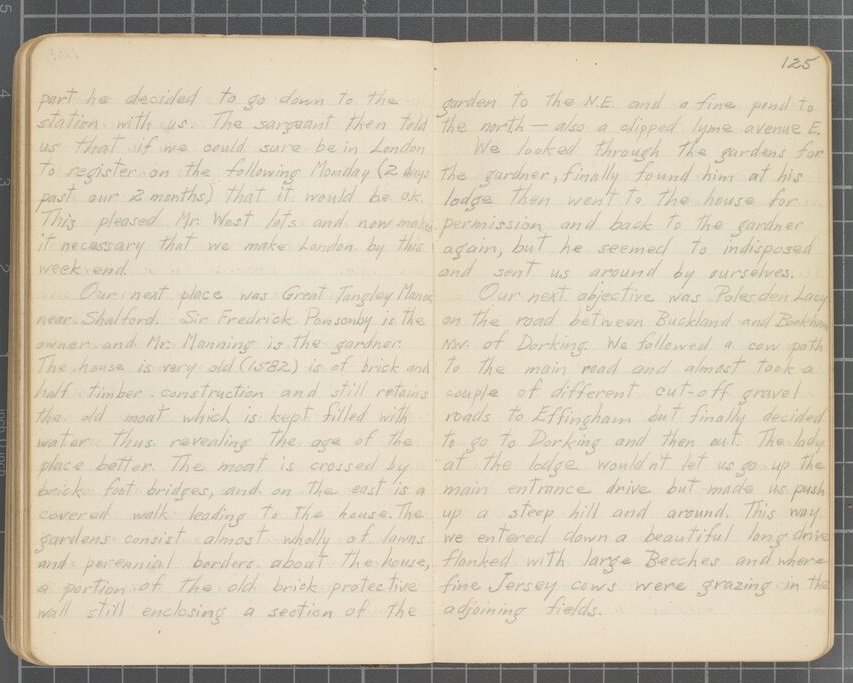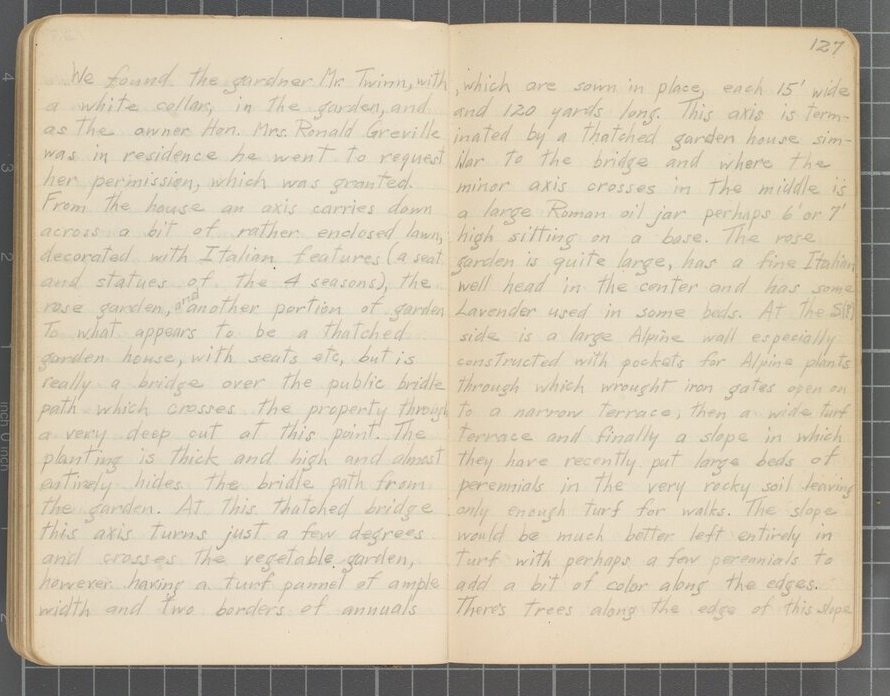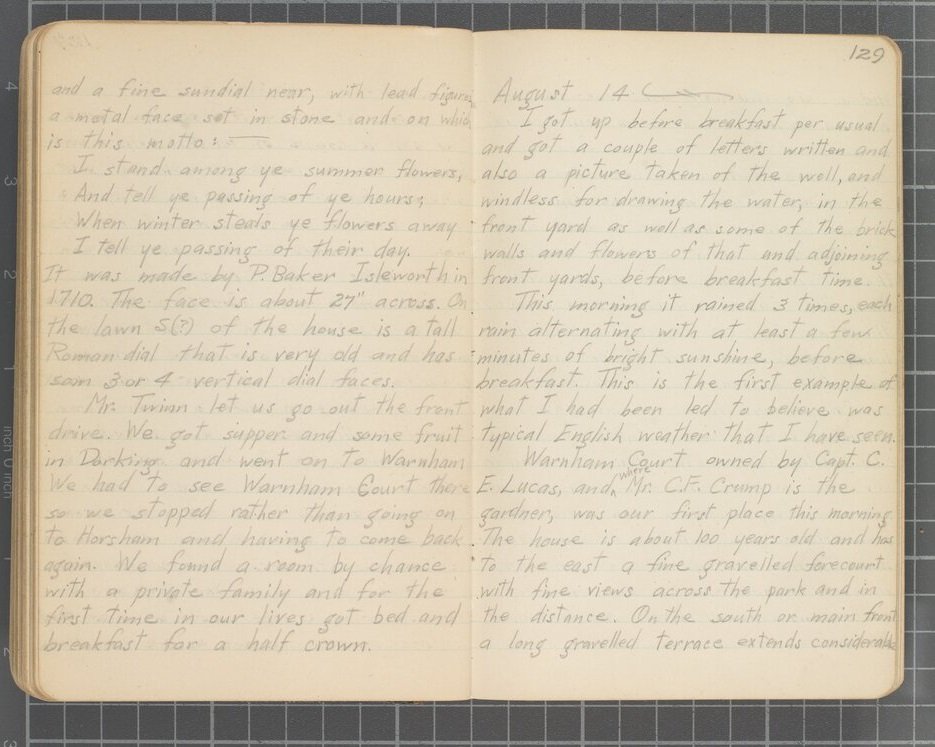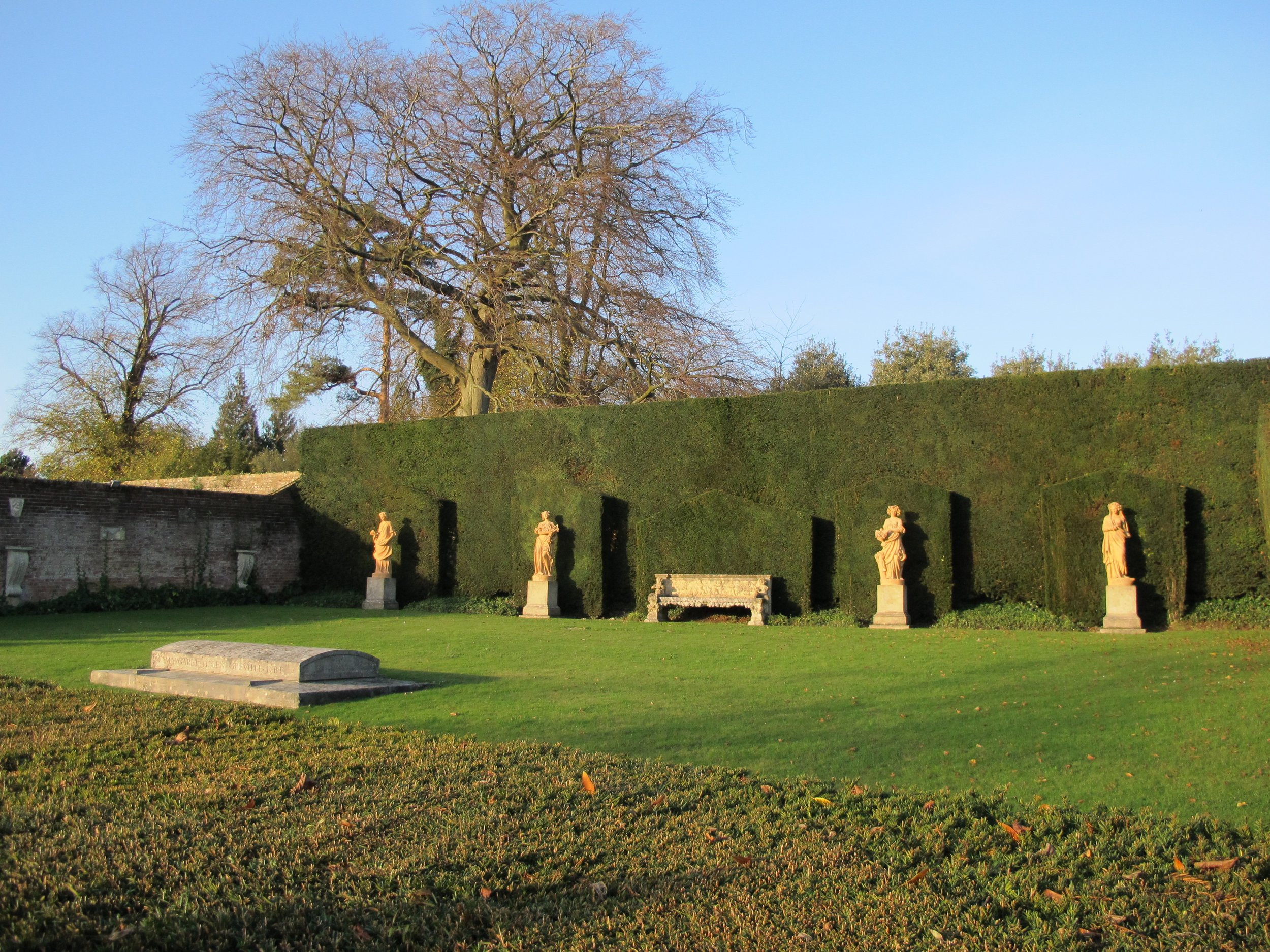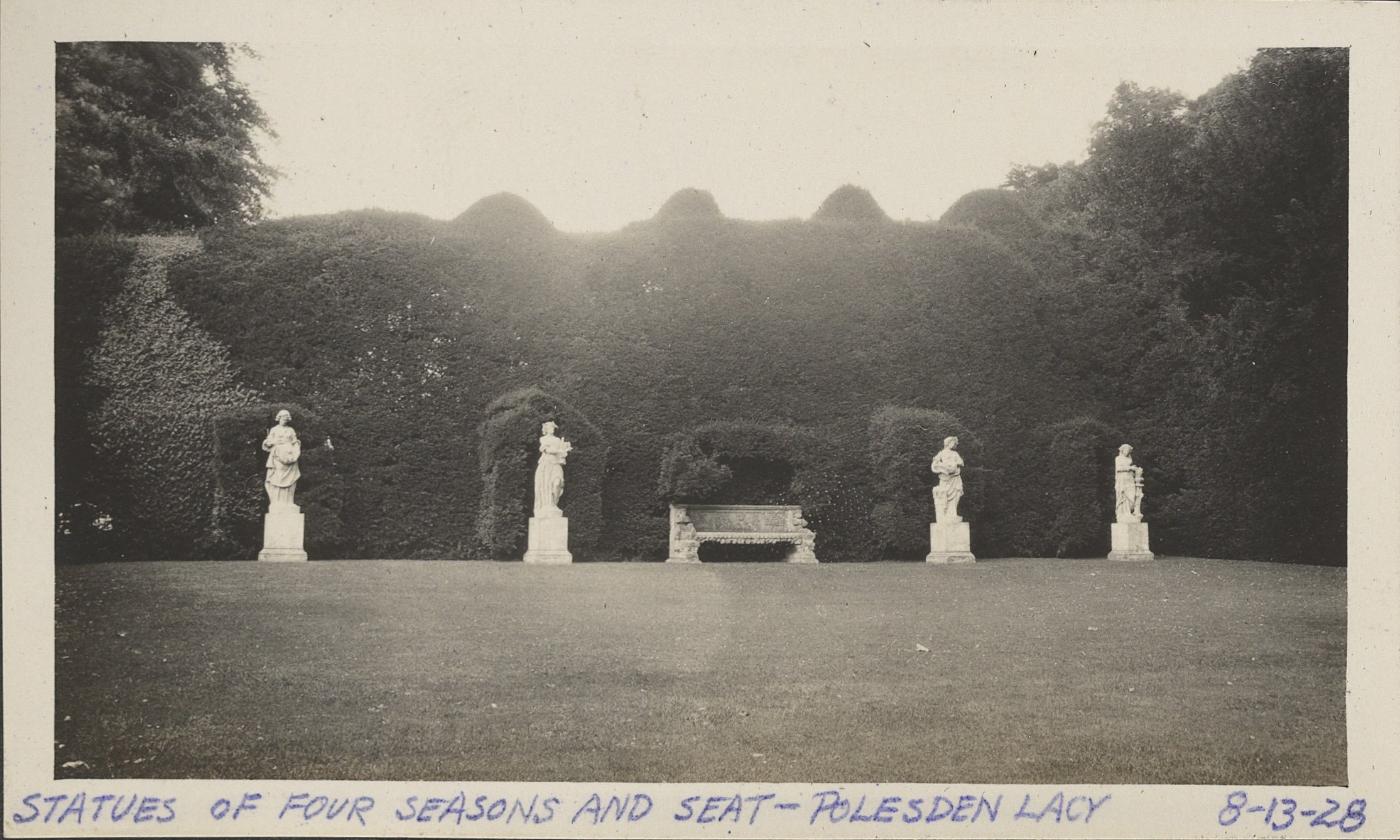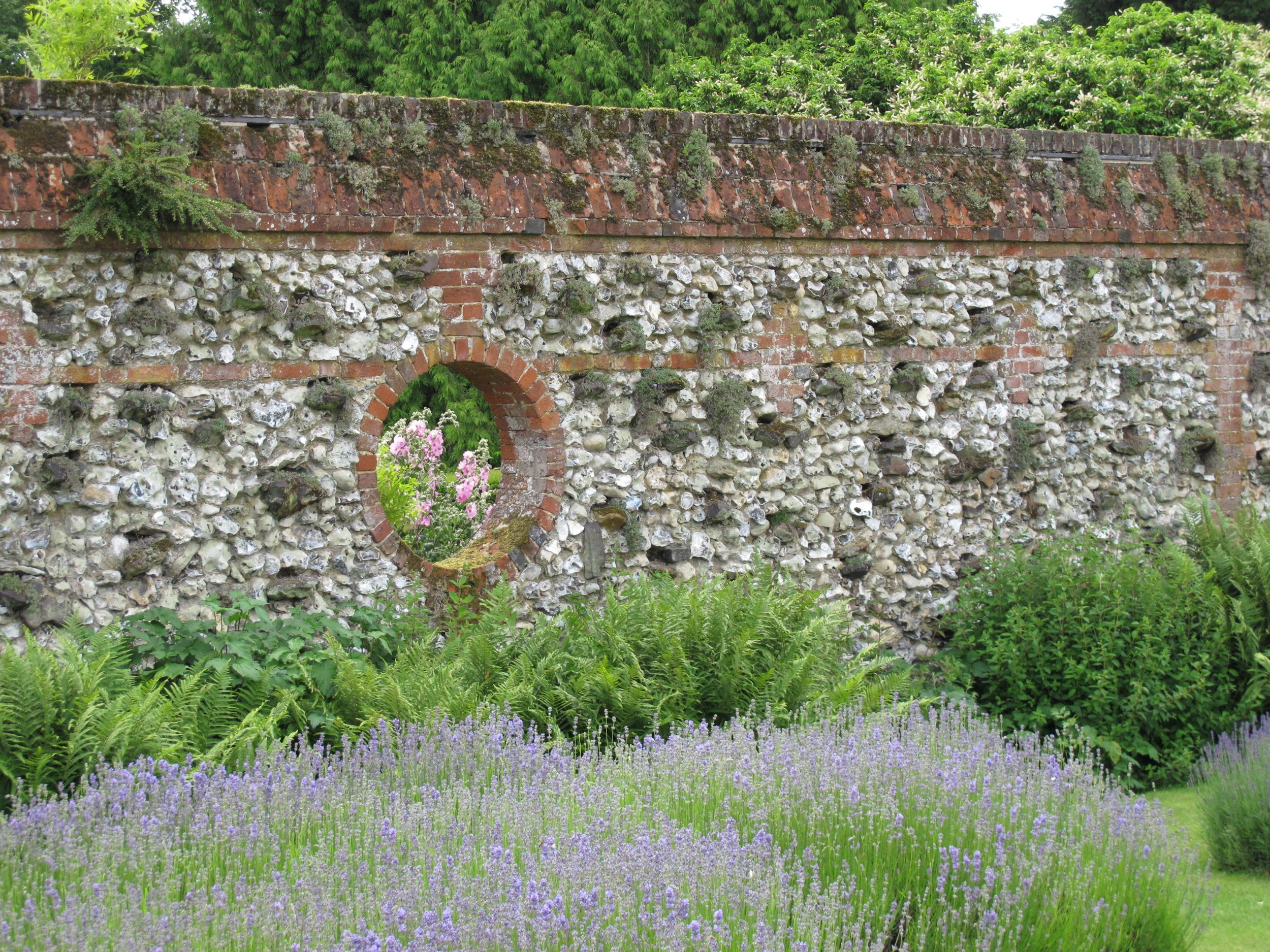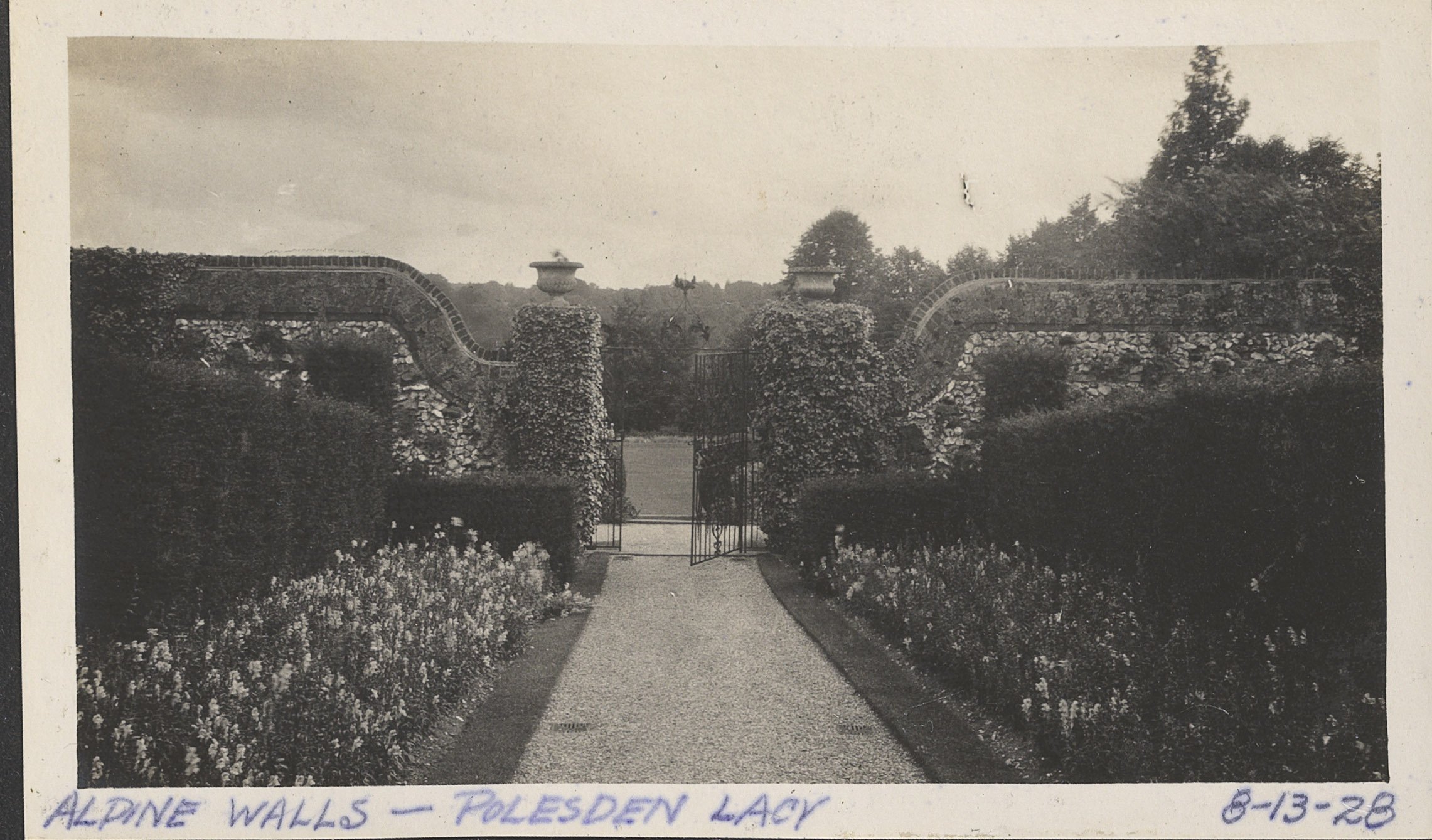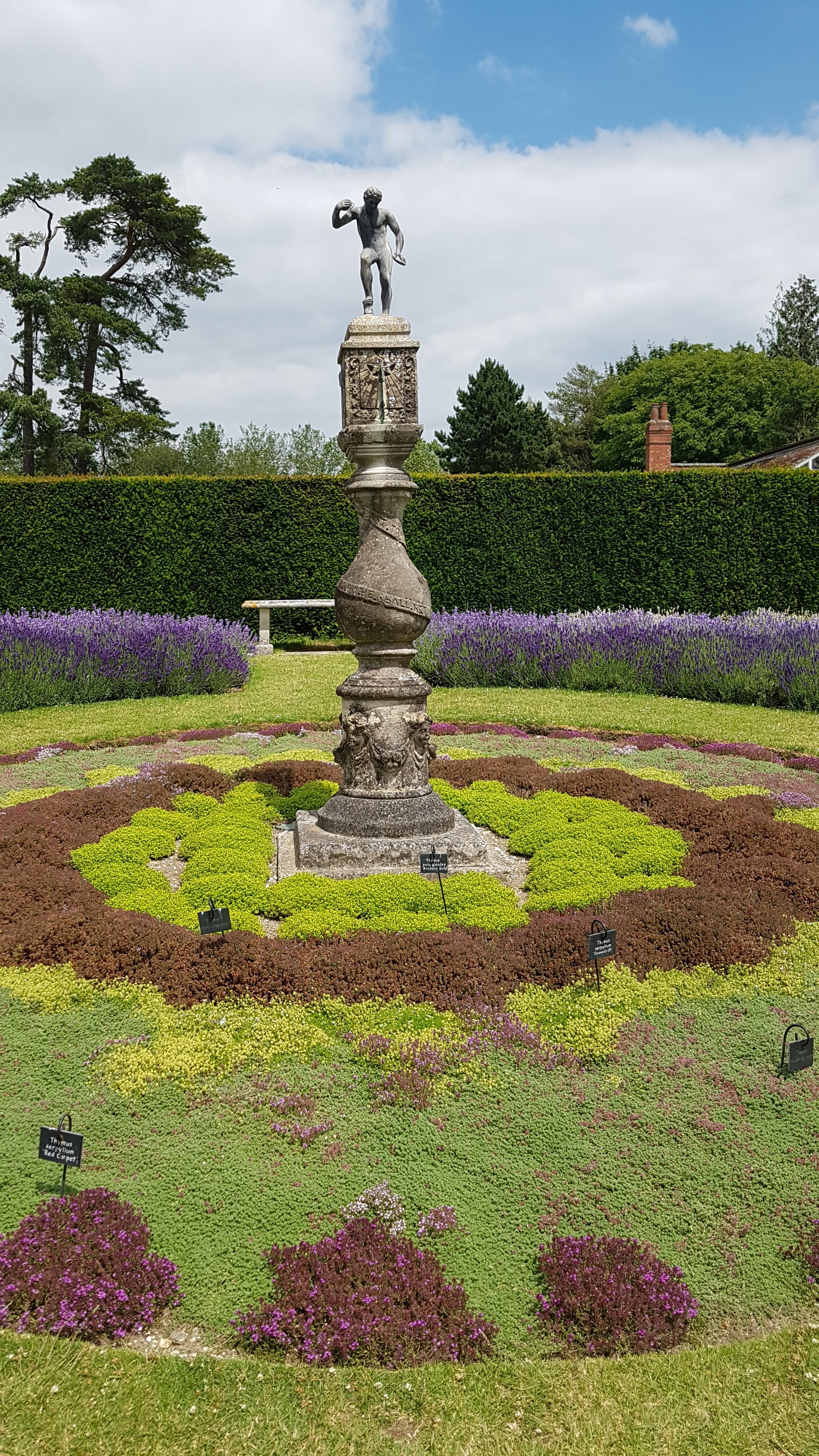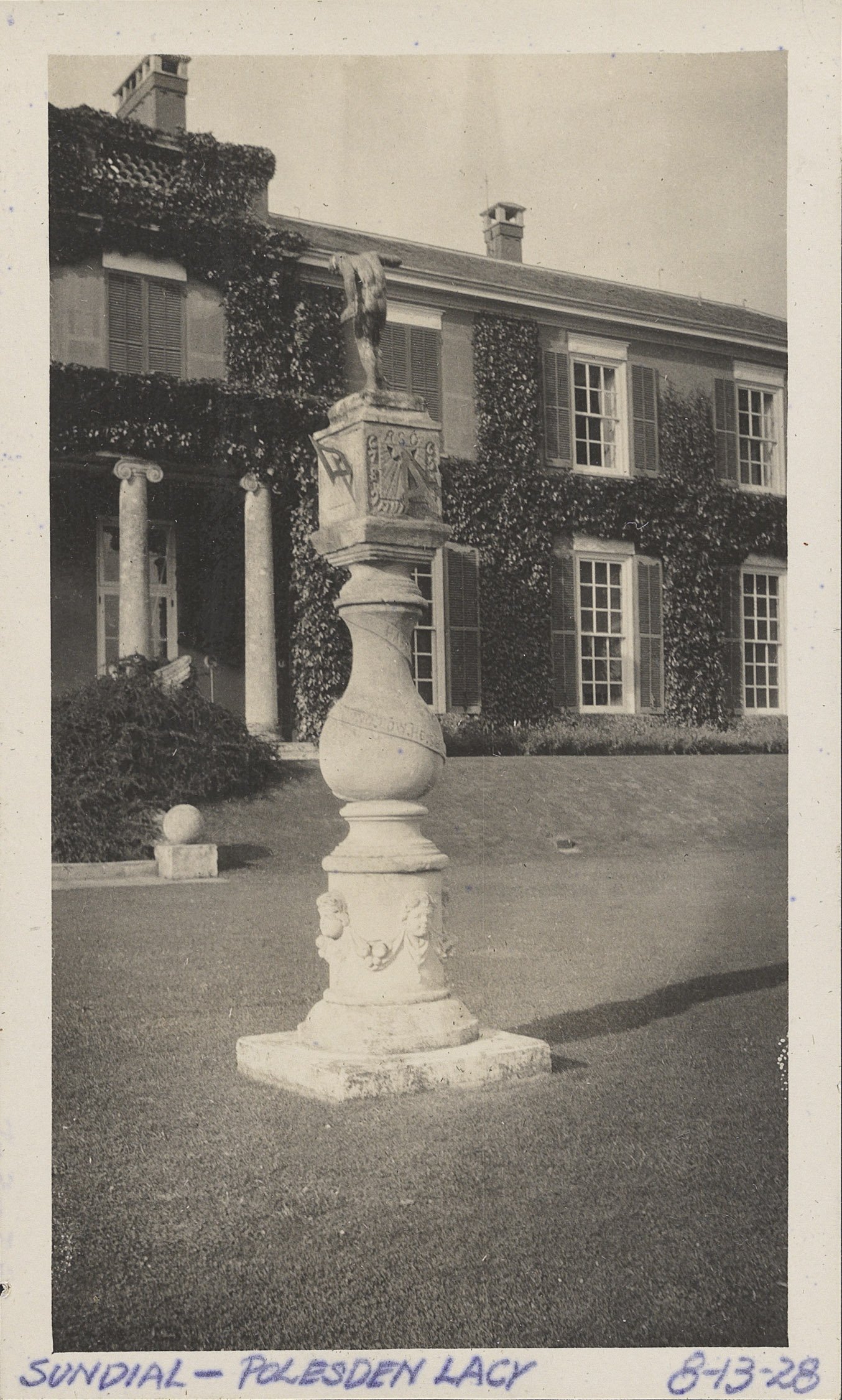The Bicycle Boys …visit Surrey
RHS Lindley Library and the Gardens Trust Exhibition
Loyal Johnson on the left and Sam Brewster on the right ©RHS Libraries Archive
We are delighted to have the opportunity to showcase one of Surrey’s very special historic landscapes, Polesden Lacey, as part of new digital exhibition by RHS Lindley Library and the Gardens Trust, in association with County Gardens Trusts, which charts a remarkable UK gardens tour by two young Americans on their bicycles in 1928. Loyal Johnson and Sam Brewster came to Britain to explore its ‘best gardens’, as part of the former’s Landscape Architecture master’s dissertation project, and in three months they cycled in excess of 1500 miles and visited more than 80 gardens.
The Exhibition is part of the Gardens Trust’s Unforgettable Gardens, #unforgettablegardens, campaign to raise awareness of the value of local parks and gardens and the importance of protecting them for our future. We did not hesitate to engage with the project to promote another Unforgettable Garden in Surrey following our successful lecture series in October 2021.
The Exhibition is available to view at rhs.org.uk/digital-collections.
The Bicycle Boys did not only visit Polesden Lacey while in Surrey and this special edition e newsletter gives you an opportunity to delve into Loyal’s journal and experience five August days on a bicycle with these intrepid adventurers through the lanes and special gardens of Surrey in 1928. Enjoy the ride!
Why is this archival material so valuable?
First a little background. Loyal Johnson’s journal provides an amazing insight into some of Britain’s greatest gardens in the early 20th century. But what has happened to the sites since Loyal and Sam’s epic cycling trip? When you visit the digital exhibition, you will appreciate that volunteers from County Gardens Trusts across the UK have researched a selection of the gardens that Loyal and Sam visited.
Surrey Gardens Trust selected the visit to Polesden Lacey as of particular interest. The Exhibition seeks to answer: ‘How have these historic landscapes and the committed teams that manage them, changed today?’ Now owned and managed by the National Trust, Polesden Lacey is an excellent example of how a private country estate and gardens has remained accessible to the public, in this instance by the good fortune that it was passed into the custodianship of the National Trust before the fallout of the Second World War.
Photograph taken by Loyal Johnson, 13 August 1928 ©RHS Libraries Archive
In our ‘pitch’ to have Polesden Lacey highlighted in the Exhibition, Marion Woodward and Brenda Lewis described why it is so special to them and so many others:
“‘The estate at Polesden Lacey is important to many people who live within a 20-mile radius. Many have visited throughout their lives, and now share this experience with children and grandchildren, as well as being popular to bring visitors from Britain and overseas.’”
With the intent that this trip would eventually be written up, Loyal kept a detailed diary with photographs and, while the dissertation was never completed or any of his work from the trip published, the family donated this journal (in three volumes) and his photographs to RHS Lindley Library in 2015. It is with reference to this journal that we are able to follow the trip and take a step back in time. In describing the gardens they visited, places they stayed and people they met, they have created a historical and social record of inter-war Britain and its gardens.
©RHS Libraries Archive
Over the course of their trip, the boys endured rain and headwinds, biting insects, poor and non-existent roads, multiple falls from the saddle, straw beds, hunger, sickness and falling out with each other. They took pleasure in the scenery, the kindness of the people they met and stayed with, and larking about together. Significantly, Loyal’s notebooks capture gardens at a significant point in the history of large country estate gardens. Ten years after the First World War, many gardens were in a state of gradual decline as post-war death duties and income tax rises impacted on the budgets and staffing levels of many private gardens. However, the vestiges of their Victorian and Edwardian heyday were still evident as the Great Depression and Second World War were still to come. It is also interesting that Loyal and Sam were often shown around by the Head Gardener rather than the garden owner, so the notebooks give important information about the staffing of the gardens they visited.
The Tour
RHS Lindley Library describes Loyal and Sam as the ‘Bicycle Boys’, #bicyleboys. Here is a map, drawn by them, which shows the route of their trip. They arrived in Liverpool on 18 June, bought bicycles on 22 June and started their tour on 23 June in Wales.
©RHS Libraries Archive
You will see from the map that in their first month, they also travelled north to Scotland by train and through Cumbria by bus, before getting back on their bikes and cycling south through numerous counties and deep into Devon.
Days in Surrey…first stop Farnham Castle …
An extract from the Tour map showing the Surrey route A little out of focus but read on and the names will come into focus as the journey unfolds ©RHS Libraries Archive
The Bicycle Boys arrived in Surrey on 9th August 1928 having cycled that day from Winchester. They arrived at Farnham Castle in the late afternoon and describe a fleeting visit. The journal entry for the visit is very typical of Loyal’s reporting.
“‘It is owned by the Ecclesiastical Commissioners and Mr A Grover is the gardener. Mr Grover was very kind in showing us about but the poor chap stutters badly. They have a fine lawn and some beautiful Cedars of Lebanon SE of the house, also a fine border of perennials and beds of single Dahlias. There’s two large sundials on the S and SE walls of the house. On top of the keep of the old castle they have a small garden, chiefly of roses laid out. There’s some excellent views from here. The place was formerly the residence of the Bishop of Winchester.’ ”
One of Loyal's photographs taken at Farnham Castle, 9 August 1928 ©RHS Libraries Archive
…next stop Guildford…
Next stop was Guildford, arriving along the Hogs Back, which Loyal explains in his journal ‘…afforded a wonderful picture of the country on either side…’, their accommodation for this stop over, ‘…after a bit of looking and some more disappointment …’ was the White’s Temperance Hotel, ‘just off the High Street’.
Loyal does not explain why they selected particular gardens to visit but his notes give some clues. Loyal writes in his journal on 10 August, ‘Making Guildford our stopping place for a time we started out to see what we could of a number of places that are within an easy radius.’
…a long day starts at Feathercombe, Hambledon
On 10 August they first cycle to visit Feathercombe in Hambledon, which Loyal notes, was then owned by Mr Eric Parker, the editor of Field, a well-known gentleman’s magazine. Perhaps this was the magnet? The garden to the house, described as ‘…brick and quite modern,’ was, Loyal notes, set out by Mr Parker and as he is quite taken by the terrace layout, he includes a sketch with his description, shown here.
Loyal’s journal, pages 108 and 109, 10 August 1928 ©RHS Libraries Archive
One of the three photographs taken at Feathercombe is this rather special piece of topiary.
Topiary at Feathercombe ©RHS Libraries Archive
… cross country to Liphook…
They then cycle 12 miles or so cross country to Little Boarhunt in Liphook, which is in fact in Hampshire. This was the garden of Mr Harry Inigo Triggs, who clearly Loyal had come across in his studies, as he explains: ‘The garden was laid out by the Mr Triggs who was very prominent in the field of and author of many works on Landscape Architecture and City Planning.’
…back over the border , next stop Godalming…
After cheese, bread and butter in the garden with Mrs Triggs, and peaches and cream and cake in Liphook, the pair cycle through the Devil’s Punch Bowl, admiring ‘its purple lined sides of heather,’ and arrive in Godalming. They do not appear to have anything planned in Godalming but, after ‘some inquiring…’, they ‘…pushed our bikes up a steep back footpath to Westbrook, owned by Thatchery Tunner Esq.’ (sic). Loyal’s miss spelling suggest that he did not know of Hugh Thackeray Turner in advance of their visit and has spelt the name phonetically.
Is this Hugh Thackeray Turner in the Dutch Garden at Westbrook? ©RHS Libraries Archive
Westbrook, a private residence, is of course, well known to us today. The house, Grade II* listed, and also designed by its then owner Hugh Thackeray Turner, has been beautifully restored by the current owners, and the gardens are Grade II registered and in equally magnificent order. We know the gardens for their association with Gertrude Jekyll who wrote about them and supplied plants from her nursery. It is thought that she gave some assistance in the planting, but this has never been verified.
Evidently, the boys were welcomed by Mr Turner himself and he was delighted to show them around his garden, described in the Historic England register entry as Mr H. Thackeray Turner’s ‘highly successful foray into garden design and a personal labour of love.’ Loyal’s journal entry perhaps indicates that it is landscape architecture that is his passion rather than Arts and Crafts garden design?
“‘Mr Tunner says that the secret of planning a garden is to put in mystery – so that one can easily loose their way in the garden. He has that here all right – so much that I don’t know how all the gardens are related to one another. However, west of the house is a sunken garden with an octagonal pool having a water level of 18” above the surrounding garden floor. This garden they call the Dutch garden and is somewhat overplanted with perennials etc. Around it are possibly 10 or a dozen other little gardens etc richly furnished with seat, nooks and tiny shelters all of which comprise the ‘mystery’ of the garden. The house faces south onto a fine turf tennis lawn.’”
…next stop Munstead House and Munstead Wood
I suspect that it was Mr Turner who directed them across Godalming to Munstead House, perhaps letting Mr Sherlock, the gardener, know that they were on their way as there is no reference in the journal to them asking permission to visit. After a brief walk around the ‘fine woods, largely of Scotch Pine, through which they have many walks among the large amount of native ferns, heather and Rhododendrons’, they are taken across the road to Munstead Wood, which Loyal amusingly describes as, ‘the place owned by Miss Gertrude Jekyll the writer on garden topics of some note, who is now 84.’(sic).
Loyal’s only photograph taken while visiting Munstead is of Munstead Tower ©RHS Libraries Archive
Loyal’s description of his visit to Munstead Wood is an example of why this journal is so precious in capturing these moments in the history of these gardens. He writes:
“‘We walked down almost endless paths in the very natural and wild woods and rather sneaked in to see the garden; for, as Mr Sherlock said, “She’s a kind of funny old biddie, and don’t want anyone to see her.” We could get a glimpse of the house down a path occasionally and went through the gardens which look somewhat like an experiment station rather than a garden for it is not tidily kept and except for about one border has little arrangement but has a wealth of wonderful material – they are just like her books in that regard. Miss Jekyll and Sir Herbert are sister and brother.’(sic)”
I am quite sure that you are all feeling exhausted just reading about this day out but there is still one further garden visit, to Orchards. Unfortunately, on their unannounced arrival, as the gardener was ill, they sought access following a discussion with the chauffeur and the butler, but the request was declined by the owner, Captain Taylor and his wife. Loyal does go onto say that it was beginning to rain and about supper time, so it is not entirely surprising. It is sad that we do not get a glimpse of Orchards, the Lutyens and Jekyll masterpiece, which would have been in its full glory.
…bike repair and relaxation in Guildford…
After a day trip to London on the 11th August to watch the Stamford Bridge Athletics Games , they spent a day pottering around Guildford on the 12th August visiting the Castle grounds which he describes as, ‘…a sort of breathing space park’. Sadly no photographs are included in the collection but it is comforting to know we can enjoy this space for all the same reasons today.
‘After making inquiry [they] had located the remaining places around Guildford as well as possible…’, and these were visited on 13th August. They included Sutton Place, then owned by the Duke of Sutherland, Great Tangley Manor near Shalford and finally to Polesden Lacey, near Dorking.
…the final Surrey day starts with a tour of the gardens at Sutton Place
The water garden at Sutton Place, 13 August 1928 ©RHS Libraries Archive
Sutton Place is afforded four pages in the journal. Refreshed by their two days off, they were clearly taken by the majesty of this garden with its avenues and statutory. Full of sketches, I am including the pages (120-123) here by way of illustration. He draws the Water Garden shown in the photograph above and the Rose Garden which he has not photographed. There is a photograph of the bathing pool, which must have been very appealing to these athletic boys on a summer’s day.
“‘To the N.W. side of the house though not directly adjoining is a walled in garden about square, with gardens houses in the northerly corner and on the N.E. side. Exactly in the center is a sizeable square bathing pool with large potted Agapanthus umbullatus at each corner.’”
‘…a sizeable square bathing pool…’ ©RHS Libraries Archive
…next stop Great Tangley Manor…
Great Tangley Manor, like Westbrook, has survived the passage of time as a cherished private residence, meticulously maintained. In 1928, Loyal records that the owner was Sir Frederick Ponsonby. The 16th century Grade I listed Manor House retains the features described by Loyal:
“‘The house is very old (1582) is of brick and half timber construction and still retains the old moat which is kept filled with water thus revealing the age of tge place better. The moat is crossed by four brick foot bridges and on the east side is a covered walk leading to the house.’”
A glimpse of the gardens looking across to Great Tangley Manor, 13 August 1928 ©RHS Libraries Archive
The gardens at Great Tangley are not registered but they do still retain the sense of the Victorian gardens as they were laid out with ‘the fine pond’ and ‘clipped lime avenue’ still in evidence as Loyal records.
…last stop Polesden Lacey…
Finally, the boys cycled across the county to Dorking, and on arrival at Polesden Lacey, then the private residence of Margaret Greville, a society hostess, they were not permitted by, ‘The lady at the lodge…to go up the main entrance drive but made [to]..push up a steep hill and around. This way we entered down a beautiful long drive flanked with large Beeches and where fine Jersey cows were grazing in the adjoining fields.’ An approach we are very familiar with today.
In the Exhibition, we have been able to offer a wonderful insight into the gardener Mr Twinn who showed Loyal and Sam around. Marion was able to build up the picture following a chance find in the National Newspaper Archive of a G E Twinn, head gardener at Albury Park, advertising for a gardener.
Gardeners at Polesden Lacey, 1920s, George Twinn, third from the left ©NT Archive
Expanding on the material set out in the Exhibition, George Edward Twinn (his father was Twin but apparently his mother thought the extra ‘n’ looked better), was born in 1893 in Hullavington, Wiltshire. In the 1901 census his father is a coachman at Harewood House in Yorkshire. By the 1911 census, George is at Byram Gardens, Ferrybridge, Yorks. He served in WWI but in 1919 and 1920 the Surrey Electoral Register shows him at RHS Bothy Wisley. He then went back to Barham and possibly moved to Knowsley, Lord Derby’s estate near Liverpool. In 1926, he married and moved to Polesden Lacey where he remained as head gardener for 12 years.
In 1939 he is at Albury Park, Surrey, and then at Juniper Hill gardens at Mickleham, Surrey. By 1951, he is head gardener at Knowsley but returns to Surrey in 1953 to work at Sutton Place. As the Exhibition documents, his final position was at Chequers.
Alex Wigley is currently the Estates Manager at Polesden Lacey, the National Trust equivalent role to Head Gardener, and it has been a pleasure to share the Loyal photographs and journal materials with him and his team. We are looking forward to working closely with the curatorial team late in the summer as the anniversary of the visit approaches in August.
Here are pages 125 - 128 from Loyal’s journal where he describes the garden and its features.
As so many of the features Loyal describes are still visible, some before and after photographs seem appropriate at this moment.
Mrs Greville’s tomb ©Marion Woodward, 2011, was placed in the garden of the statues of the four seasons, shown on the right in 1928 ©RHS Libraries Archive
The alpine wall in 2012 ©Marion Woodward, described by Loyal as ‘…a large Alpine wall especially constructed with pockets for Alpine plants…’ , again also shown in 1928 ©RHS Libraries Archive
The sundial seen on the right in July 2019 ©Marion Woodward, has evidently been relocated from its position in 1928 ©RHS Libraries Archive. Loyal has copied the inscription on the dial into his journal and it seems an appropriate note to end this part of their story.
“I stand among ye summer flowers,
And tell ye passing of ye hours;
When winter steals ye flowers away
I tell ye passing of their day. ”
The Bicycle Boys journeyed on into Sussex and you can follow their path by returning to the Digital Exhibition rhs.org.uk/digital-collections.
Editor’s Note
I have not been able to share all of the photographs and journal pages relating to the Surrey visits with you here. If you are particularly interested in any element of this wonderful story please do get in touch an I will be very happy to share any further information I have.













